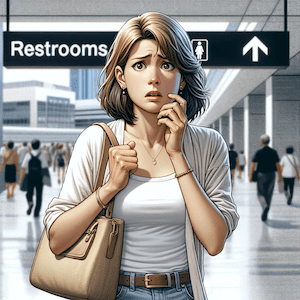Overactive Bladder (OAB) & Urge Incontinence
Article by Nadine Stewart
Urgency / Overactive Bladder (OAB) and Urge Incontinence
Introduction to Overactive Bladder and Urge Incontinence
Experiencing the sudden and intense need to urinate can be distressing and disruptive. This condition, known as Overactive Bladder (OAB), often leads to what we call Urge Incontinence – an involuntary loss of urine following an urgent need to void. Not everyone with OAB experiences incontinence, but the urgency can be overwhelming.

Unpacking the Causes
At the heart of Urgency / OAB and Urge Incontinence lies the detrusor muscle. This muscular wall of the bladder contracts too early, often when the bladder isn’t full. Normally, you would feel a gradual urge to urinate as your bladder fills. However, for those with OAB, this process is unpredictable and uncontrollable.
Triggers vary widely, from the sound of running water to simply entering your home. Factors such as the type of fluids consumed, recurrent urinary tract infections (UTIs), and incomplete bladder emptying contribute significantly. Medical conditions like cognitive decline, neurological disorders, nerve damage, diabetes, and even certain medications can precipitate this condition.
Symptoms
The hallmark symptoms of Urgency / OAB and Urge Incontinence include:
- Urgency: An immediate, overwhelming need to urinate.
- Urge Incontinence: Loss of urine following a sudden urge.
- Frequency: Needing to urinate more than six times a day.
- Nocturia: Waking up multiple times at night to urinate.
Diagnosis: More Than Just Symptoms
Diagnosis typically involves a thorough review of symptoms and a physical examination. In some cases, additional tests like bladder diaries or urodynamic studies might be necessary.
Physiotherapy: A Frontline Treatment
Physiotherapy plays a pivotal role in managing OAB and Urge Incontinence. Treatment strategies include:
- Education: Understanding the condition is crucial.
- Lifestyle Recommendations: Dietary changes and fluid management can make a significant difference.
- Bladder Retraining: Teaching the bladder to delay voiding.
- Trigger Retraining: Learning to manage environmental cues that stimulate urgency.
- Bladder Drills: Techniques to increase bladder control.
- Electrical Stimulation: Aiding muscle control and nerve function.
Recent research has emphasised the effectiveness of these non-surgical methods, especially when tailored to individual needs.
What to Expect from Treatment
Most individuals experience a significant improvement in their symptoms with dedicated physiotherapy. The key is early intervention; delaying treatment can exacerbate the problem.
Is Surgery Necessary?
Surgery is rarely required. However, a small percentage of individuals who do not respond to physiotherapy and medical management might need surgical intervention.
Conclusion: Take Control of Your Bladder Health
Living with Urgency / OAB and Urge Incontinence can be challenging, but it’s not insurmountable. With the right guidance and treatment, you can regain control and improve your quality of life. Remember, physiotherapy is an effective and non-invasive approach to managing these conditions. Don’t hesitate to seek professional advice from a physiotherapist with a special interest in pelvic floor conditions.
Rochedale - Call 38410277
Book Online: RochedaleSalisbury - Call 32751044
Book Online: SalisburySandgate - Call 32691122
Book Online: SandgateFAQ: Understanding Urge Incontinence and Overactive Bladder
- What is overactive bladder?
- Overactive bladder (OAB) is a condition characterised by a sudden, intense urge to urinate, which can lead to involuntary urine leakage.
- What is urge incontinence?
- Urge incontinence is the sudden, involuntary loss of urine following an urgent need to urinate, often linked with overactive bladder.
- What causes overactive bladder?
- Causes include early contractions of the detrusor muscle, certain fluids, UTIs, neurological disorders, diabetes, and medications.
- How is overactive bladder diagnosed?
- Diagnosis involves reviewing symptoms, physical exams, and possibly bladder diaries or urodynamic studies.
- Can physiotherapy help with overactive bladder?
- Yes, physiotherapy offers non-surgical treatments like bladder retraining, dietary changes, and electrical stimulation to manage symptoms.
- When is surgery needed for overactive bladder?
- Surgery is rarely needed and is only considered if physiotherapy and medical management fail.
- How can I manage my overactive bladder symptoms?
- Managing symptoms involves lifestyle changes, physiotherapy, and staying informed about effective treatments.
- How is urge incontinence diagnosed?
- Diagnosis involves reviewing symptoms, physical exams, and possibly bladder diaries or urodynamic studies.
- Can physiotherapy help with urge incontinence?
- Yes, physiotherapy offers non-surgical treatments like bladder retraining, dietary changes, and electrical stimulation to manage symptoms.
- When is surgery needed for urge incontinence?
- Surgery is rarely needed and is only considered if physiotherapy and medical management fail.
- How can I manage my urge incontinence symptoms?
- Managing symptoms involves lifestyle changes, physiotherapy, and staying informed about effective treatments.
Related Articles
- Pelvic Floor Muscle Training: Discover exercises to strengthen your pelvic floor muscles.
- Stress Incontinence: Learn about stress incontinence and how to manage it.
- Pelvic Floor Dysfunction: Explore symptoms and treatments for pelvic floor dysfunction.











